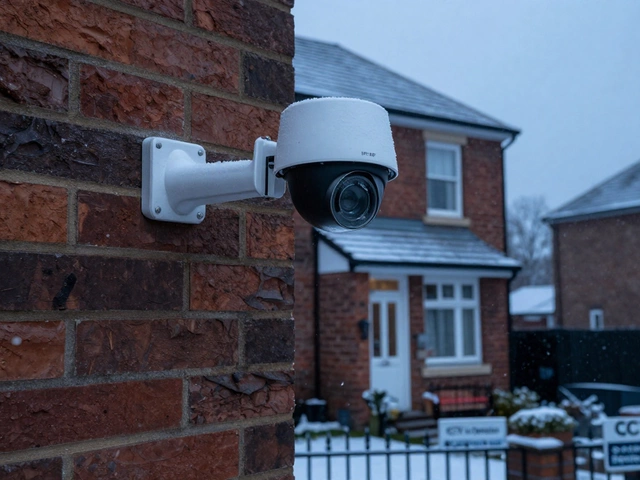Here’s something you probably didn’t realize until your dog set off your alarm at 2 AM: regular house alarms don’t get along with pets. Most cheap motion detectors are way too sensitive. They see your cat jump onto the windowsill, and suddenly your whole street wakes up. Even your goldfish turning on a filter can sometimes trigger old-school systems—seriously, it happens.
The good news? Security companies finally got the memo. Now, pet-friendly alarms are everywhere. They’re not just clever marketing either. These systems use smarter motion sensors, so they tune out dogs, cats, and rabbits moving below a certain height or weight. That means you can keep your house secure without sending your pup into panic mode every night.
- Why Standard Alarms and Pets Clash
- How Pet-Friendly Sensors Work
- Top Features for Pet Owners
- Real-World Setups and Common Blunders
- Tips to Avoid False Alarms
- Best Brands and What to Expect
Why Standard Alarms and Pets Clash
Most house alarms aren’t made with pets in mind. Typical motion sensors work by detecting heat and movement—anything bigger than a mouse can set them off. This means your dog heading to his water bowl or your cat exploring the shelves can look like a break-in to your average alarm. A 2020 survey by a leading security company even found that 40% of pet owners with basic motion sensors had experienced at least one false alarm caused by their pet. That’s not just annoying, it’s stressful and can lead to neighbors ignoring real alerts.
Standard alarms also don’t care if the “intruder” has four legs and a tail. Most will blast the siren whenever they sense movement in their field, especially at night when pets tend to roam. Over time, false alarms can desensitize everyone in the house (and even emergency services) to the system, defeating the point of having any sort of security in place.
If you use a systems that includes glass break or shock sensors, it gets more complicated. Dogs hitting the window or cats knocking things over can trip these sensors, too. So in homes with pets, traditional setups are more likely to annoy you than catch an actual thief.
All this adds up to one thing: if you have pets and a regular home alarm, you’re pretty much asking for trouble. The solution? Look for house alarm with pets features that actually understand your furry roommates aren’t burglars.
How Pet-Friendly Sensors Work
If you’ve ever tried using a standard home security setup and failed, you’ll love how pet-friendly sensors flip the script. These sensors basically tell the difference between a person sneaking around and your dog stretching his legs at midnight.
Here’s what makes them tick:
- Weight Limits: A lot of sensors are set to ignore anything under a certain weight. You’ll usually see systems rated for pets up to 40 or even 80 pounds. This filter is all about letting your pets move around while still catching someone bigger.
- Infrared Smart Detection: Instead of reacting to just any movement, these sensors focus on heat signatures. Because pets give off less body heat than people, the sensor knows not to trip the alarm when your cat slinks across the room.
- Height Range: Sensors often aim high—literally. Some adjust where they’re looking so a dog snuffling near the floor doesn’t set them off, but a standing adult will.
A lot of pet owners have asked if this stuff actually works or if it’s just hype. Here’s some real data from a 2024 report by SafeHome:
| Sensor Type | False Alarm Rate (with pets) | Pet Weight Tolerance |
|---|---|---|
| Standard PIR Motion Sensor | 35% | <10 lbs |
| Pet-Friendly Infrared Sensor | 7% | Up to 80 lbs |
The difference is obvious. The newer tech really does skip the drama with pets and cut down on useless alerts. Just remember, these sensors still need to be set up right—mounting them too low or in your pet’s favorite path can cause problems. Always follow the how-to guide that comes with your equipment and take note of your pet’s usual routes around the house.
Top Features for Pet Owners
If you’re serious about adding a house alarm with pets to your home, don’t just grab the first system you see. There are a few must-have features that actually make your setup work when you’ve got animals roaming around. Here’s what really matters:
- Pet-Immune Motion Sensors: These sensors ignore movements from pets under a certain weight—usually 40 or even 80 pounds. Brands like Honeywell and SimpliSafe let you set this up so your alarms don’t go wild every time your dog walks by. If you’ve got a St. Bernard, double check the system’s weight cutoff before you commit.
- Custom Sensor Placement: How you aim motion sensors is just as important as what kind you buy. You want them pointed high enough to spot people, but not your labradoodle or cat. Most companies will explain the sweet spot in their setup guide, but a little trial and error goes a long way.
- Glass Break Detectors: If your pets get curious and press against windows, motion detectors might not be your friend. Glass break sensors are great backups—they focus on the sharp sound of breaking glass and nothing else.
- Camera Integration: Smart cams can filter out animals from actual security risks. If your alarm goes off, you can check your phone to see if it’s just your dog chasing his tail (again) or something serious.
- Sensitivity Settings: Some high-end systems let you adjust how reactive the sensors are. This is perfect if you have a few cats or a small dog pack. More sensitivity means more false alarms, so tone it down if your pets love to jump and run everywhere.
- Zone Control: You can set things up so certain rooms are monitored, and others aren’t. If your cat always naps in the laundry room, just leave that space out of your system’s watch list.
These features make a real difference. No one wants to sprint home after a false alarm triggered by a playful kitten or a tail-wagging retriever. Invest in a setup with these options and you’ll get security without the daily hassle.

Real-World Setups and Common Blunders
Lots of people get excited about upgrading to a house alarm with pets, but there are some things that trip up almost everyone. Most issues start at setup—either forgetting what your pet actually does during the day or just using the default settings out of the box.
Here’s one thing that keeps popping up: people install motion sensors pointing at staircases or couches, then wonder why they get so many late-night alerts. Dogs love couches, and cats think your stairs are their personal racetrack. Experts always say, place sensors above animal height or aim them away from regular pet hangouts.
Check this table for some classic mistakes and how you can avoid them:
| Blunder | Why It Happens | Simple Fix |
|---|---|---|
| Sensors too low | Placed at human thigh level | Install above 4 feet, tilted down |
| Ignoring pet weight setting | Forgetting to adjust for pet size | Set device to match heaviest pet |
| Loose blinds or curtains | Cats brushing or climbing surveys | Keep cords up, avoid direct field |
| Too many motion zones | Overlapping fields of view | Limit sensors, map out room first |
Another overlooked thing is glass break alarms. Some older models activate from loud dog barks. Setting the right sensitivity—or getting a newer version that ignores barking—saves a ton of headaches (and angry neighbors).
Here's what usually works best in real homes:
- Use entry sensors on doors and windows pets can’t reach.
- Skip motion sensors in busy pet areas or set them to pet mode.
- Test your setup by walking through the room like your pet would—crawl if you have to. See what triggers the alarm.
- Check the app notifications for a week. If your phone keeps buzzing, adjust right away instead of procrastinating.
Finally, remember: it’s easier to do a little planning and testing up front than to deal with a system that panics every time the cat jumps off the fridge. Most brands offer online guides just for pet owners, and swapping one or two sensors can instantly drop those false alarms.
Tips to Avoid False Alarms
Nobody likes running down the hall in the middle of the night just to realize your dog triggered the system again. So, how do you keep your house alarm with pets from freaking out over every little tail wag? Here’s what actually works:
- Adjust the sensor placement: Standard advice says to mount motion sensors at chest height, but with pets, try mounting them a bit higher so they don’t watch the floor all the time. Make sure they aren’t aimed at furniture your cat loves or at stairways where pets often roam.
- Use the right sensor settings: Most pet-friendly sensors can be set by weight or height. If you’ve got a bigger dog (like a Labrador), double-check the specs—some sensors ignore pets only up to about 40 pounds. Set the sensitivity as low as you can without missing actual intruders.
- Block off pet zones: Close doors to rooms pets use when you’re gone. You can skip sensors in those rooms or deactivate them when you know the pets will be moving around inside.
- Train your pets (a little): Okay, you can’t tell your cat not to leap on the curtains, but if your dog jumps near windows or doors that are armed, you can use some basic training to keep them away from these trigger spots when you’re not home.
- Test everything: Before you trust your alarm, arm it and walk around with your pets. See what sets it off and adjust. Most companies have a test mode for this exact reason.
- Regular maintenance: Dust and spiderwebs aren’t just gross—they mess with sensors. Give your alarm system a quick dusting every few weeks to keep it working right.
If you just grab whatever alarm’s on sale, you’re gambling with your sleep and your sanity. Take some time to set things up right for your unique home and pets. Better sensors and a bit of planning mean you’ll get real protection, not panic attacks every time the cat gets the zoomies at 3 AM.
Best Brands and What to Expect
Not all pet-friendly alarms live up to the hype. A few brands have really figured out the balance between tight security and happy pets. Let’s break down what’s out there and why it actually matters which system you pick.
SimpliSafe, ADT, and Ring are three standouts. SimpliSafe’s pet-friendly motion sensors are famous for handling pets up to 50 pounds without flinching. Ring’s sensors can also be adjusted so it doesn’t freak out just because your cat does laps at midnight. ADT, with its pro install and monitoring, includes sensors that ignore pets under 60 pounds. The main thing these brands have in common? Their tech isn’t just about sensitivity—it’s about real, adjustable settings. That means your security fits your pet, not the other way around.
You’ll want to see how they stack up before you click ‘buy.’ Here’s a quick comparison:
| Brand | Pet Weight Limit | Adjustable Sensitivity | Monthly Cost (Monitoring) | DIY or Pro Install |
|---|---|---|---|---|
| SimpliSafe | Up to 50 lbs | Yes | $18-28 | DIY/Pro |
| Ring | Up to 55 lbs | Yes | $10-20 | DIY |
| ADT | Up to 60 lbs | Yes | $36-60 | Pro |
The best part? With these brands, setting up your house alarm with pets really is as simple as checking a box or sliding a little dial when you set up the system. No code-writing, no weird workarounds. But don’t just take my word for it. According to SafeWise, a site that actually tests these things:
“Modern pet-immune motion sensors let you stop worrying about false alarms and focus on what matters most—keeping your family, furry or not, safe.”
One last heads-up: always double-check the size and habits of your pet. If your dog’s 65 pounds and likes to jump, you might need to tweak sensor placement—most brands recommend sensors sit 6-8 feet off the ground and angled away from furniture your pets climb. And if you ever switch brands, run a test with your own pet before relying on it. Just set the alarm, let your pet roam, and see what happens. Better safe than sorry—and way better than apologizing to your neighbors after a false alarm at 3 AM.






